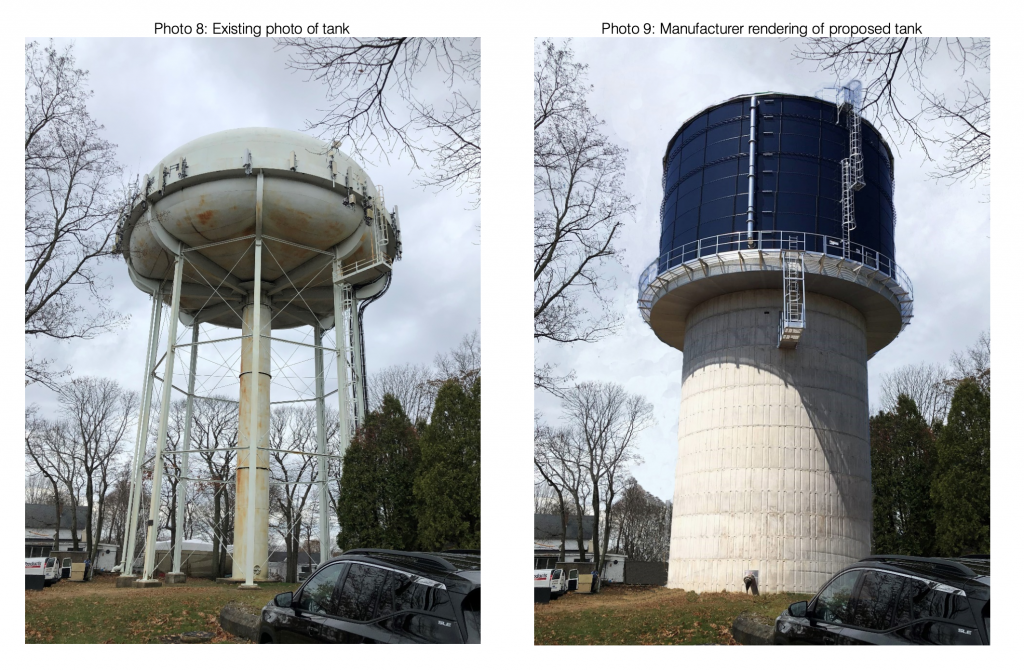Reading, MA — The Community Planning and Development Commission (CPDC) opened its public hearing for site plan review of the Auburn Street water tower replacement on February 22. Town Engineer Ryan Percival presented the project, which proposes to replace the current water tank, built-in 1953, with a new tank made out of a glass and steel composite material that would require little maintenance.

The current tower is in need of costly painting. Other concerns include rusting, deteriorating walls, and a catwalk that was not designed to hold the cellular equipment for the three current carriers that use it. The town’s emergency radio communication equipment is also located on the tower.
According to Percival, this “ideal-style” new tank would sit on top of a concrete column and rise to approximately the same height. It would be placed in the same location as the current tower. The new tank will have the same 750,000 gallon capacity as the existing tank. Percival commented that the new tank should have a greater than 40-year life expectancy. Percival also explained that a temporary monopole tower would be constructed on the site to hold the emergency equipment during construction. This equipment will be moved to the new water tower once it is completed.
The cellular companies which use the current tower have been advised that they will need to relocate their equipment to a new location during construction. Percival made clear that there is no room on the site for temporary cell on wheels (or “COW”) towers on the site. He also indicated that a COW tower is not advisable as a temporary tower for the town’s equipment as the COWs have wind and ice limitations that could take them offline during a storm.
Mike Warner of Weston and Sampson shared that there are a few locations on the site that have been contaminated by flaking lead paint, mostly from the former “rocket” tower that once occupied the site. The town plans to remove up to 12 inches of topsoil from these areas to mitigate this exposure. There are also two areas east of the current security fence, in a heavily wooded area, that slightly exceed the recommended 200 parts per million of lead. The town proposes to move the security fence around the site twenty feet to the east to contain the lead, as permitted by the Department of Environmental Protection, and preserve the mature, healthy trees in the area.
Several abutters expressed concern regarding moving the fence and further limiting access to the open space in the wooded area. Percival indicated that merely removing the dirt around the trees in question could damage the trees’ root systems, eventually killing them, but did advise that alternative options to moving the fence would be explored.
Abutters also did not care for the tower’s color, which comes from the factory in a cobalt blue hue. While the new material should not be painted, other colors are available, but at a significant cost increase to the project.
CPDC continued the public hearing to March 8 at 8:30 pm.
CPDC voted 4-0 to approve the site plan review for 1310-1312 Main Street. The Reading Animal Clinic, currently located at 1310 Main Street, intends to build a new 10,959 square foot two-story wood-frame building on the lot next to the current structure. The plan also calls for 47 parking spaces to be shared by the two buildings.
Speaking for the applicant, Attorney Josh Latham informed the CPDC that the project had met Conservation Commission review. The order of conditions from that commission was expected this week. Project engineer Jack Sullivan explained that it was determined that there are wetlands at the rear of the site, and some of the parking had been reconfigured to meet the required 35-foot wetlands buffer zone. He also noted that additional walkways had been added to the plan at some of the building exits.
CPDC also held a continued hearing for the rearrangement of traffic on the Bagel World site at 323 Main Street. John Bobreck, the project engineer, explained the plan to “revamp and add a second drive-through lane” around the building. This dual lane would merge into one lane for product pick-up after orders are placed. A third lane will allow customers to bypass the drive-through around the building as well. The south entrance to the property would be for drive-through only customers, while the northern entrance would be for those parking and entering the building.
Bobreck reported that based on CPDC input, the dumpster area had been reconfigured. A new high-definition speaker system is going to be installed to help mitigate noise pollution from the site. He also gave an overview of results from a renewed traffic study that showed that during peak weekday hours of operation, the site is at capacity 28 percent of the time. On weekends, the site is at capacity just under 100% of the time during peak hours of operation. “The ultimate goal is to alleviate back-ups,” Bobreck stated.
CPDC chair John Weston expressed concern that the swing radius for cars at the southeast corner of the building was insufficient and would create problems. He also wondered what cars entering the northern entrance would do under the current proposal if there was no parking in front of the building. Bobreck shared that his team would study several of the suggestions made by the CPDC. CPDC continued the hearing to March 8 at 9:30 pm.
As the meeting was closing, Staff Planner Andrew MacNichol shared that the board would be reviewing a new 40R application for 18 Woburn Street on March 8 as well.
The CPDC adjourned at 11:10 pm.
